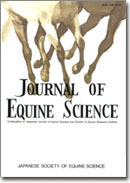All issues

Volume 25 (2014)
- Issue 4 Pages 65-
- Issue 3 Pages 57-
- Issue 2 Pages 29-
- Issue 1 Pages 1-
Volume 25, Issue 3
Displaying 1-2 of 2 articles from this issue
- |<
- <
- 1
- >
- >|
Note
-
Christina L. BUTLER, Katherine Albro HOUPTArticle type: Note
2014Volume 25Issue 3 Pages 57-59
Published: 2014
Released on J-STAGE: October 03, 2014
JOURNAL FREE ACCESSThe objectives of this study were to determine the prevalence of pawing behavior in a population of Standardbred racehorses and the relationship of pawing frequency to time of day. Standardbreds (n=41) were observed using instantaneous scan sampling twice daily, in the morning before training and in the afternoon after training. A majority of the horses, twenty-four (58.5%) of the 41 horses showed pawing behavior at least once (median=7, interquartile range=2–15). After training, there were a median of 4 (interquartile range 1–11) observations of pawing or 11.2% of total observations. In the morning, before training, there were 3 (0–3.25) pawing observations, or 9.1% of total observations. There was a significantly greater frequency of pawing in the afternoon (P=0.0005). They pawed less on Sunday afternoons when they had not trained. Pawing may be related to exercise and, possibly, discomfort.View full abstractDownload PDF (387K) -
Fumio SATO, Ryo SHIBATA, Mitsumori SHIKICHI, Katsumi ITO, Harutaka MUR ...Article type: Note
2014Volume 25Issue 3 Pages 61-64
Published: 2014
Released on J-STAGE: October 03, 2014
JOURNAL FREE ACCESSRupture of the gastrocnemius muscle is occasionally found in neonatal foals associated with dystocia and assisted delivery. In this report, 3 cases of gastrocnemius muscle disruption in newborn Thoroughbred foals (6, 5 and 2 days old) are reported. In all cases, the foals were presented with inability to rise unassisted postpartum, a dropped tarsus and swelling in the caudal aspect of the thigh accompanied by a hematoma. Ultrasonography, radiography, computerized tomography (CT) and subsequent autopsy were performed to confirm the clinical and pathological features of these cases.View full abstractDownload PDF (1725K)
- |<
- <
- 1
- >
- >|